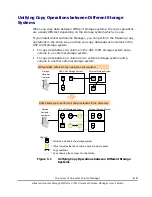
2-12
About Universal Volume Manager Operations
Hitachi Universal Storage Platform V/VM Universal Volume Manager User’s Guide
•
In the
Single
mode, only the path with the highest priority (primary path)
is used to execute the I/O to the external volume. When an error occurs in
the primary path, the path with the second highest priority is used.
•
In the
Multi
mode, all of the set paths are used at the same time. The
multiple paths are used to execute the I/Os to the external volume thus
distributing the work load (round-robin processing).
For example, when a volume in the external storage system with the path
mode of the Single mode is mapped as an internal volume using Universal
Volume Manager, the host I/O operations to the external volume are enabled
using the primary path set in the mapping operation. The path is automatically
switched to the alternate path when the primary path set in mapping operation
cannot be used due to, for instance, maintenance operation in the storage
system, or a failure in the channel processor. Because the path is switched to
the alternate path, the I/O operation to the external volume continues even
though an error occurred in the original path.
Note:
When the primary path cannot be used for three minutes continuously,
the path is switched to the alternate path.
Examples of Alternate Paths
Figure 2-3 illustrates an example of setting an alternate path. External storage
system ports, “WWN A” and “WWN B”, are connected to “CL1-A” and “CL2-A”
respectively, which are set to the external ports in the local storage system.
You need to specify the port of a different cluster in the local storage system
for the alternate path. Therefore, “CL1” port and “CL2” port are specified.
















































